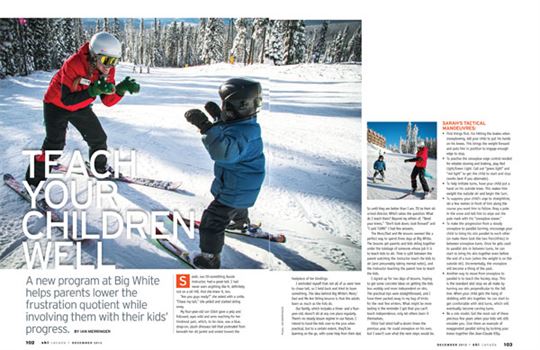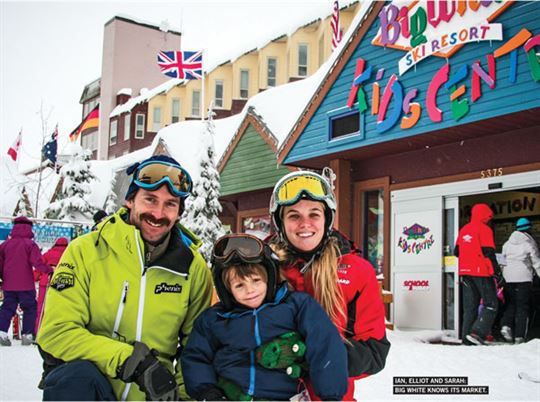A new program at Big White helps parents lower the frustration quotient while involving them with their kids’ progress.
by Ian Merringer in December 2013 issue

Sarah, our 20-something Aussie instructor, had a great tail. I had never seen anything like it, definitely not on a ski hill. And she knew it, too.
“Are you guys ready?” she asked with a smile. “Chase my tail,” she yelled and started skiing away.
My four-year-old son Elliot gave a yelp and followed, eyes wild and arms reaching for her hindmost part, which, to be clear, was a blue, strap-on, plush dinosaur tail that protruded from beneath her ski jacket and ended toward the heelpiece of her bindings.
I reminded myself that not all of us were here to chase tail, so I held back and tried to learn something. The idea behind Big White’s Mom/Dad and Me Are Skiing lessons is that the adults learn as much as the kids do.
Our family, which includes a three- and a four-year-old, doesn’t ski at any one place regularly. There’s no steady lesson regime in our future. I intend to hand the kids over to the pros when practical, but to a certain extent, they’ll be learning on the go, with some help from their dad. So until they are better than I am, I’ll be their ski school director. Which raises the question: What do I teach them? Beyond my refrain of, “Bend your knees,” “Don’t look down, look forward” and “I said TURN!” I had few answers.
The Mom/Dad and Me lessons seemed like a perfect way to spend three days at Big White. The lessons get parents and kids skiing together under the tutelage of someone whose job it is to teach kids to ski. Time is split between the parent watching the instructor teach the kids to ski (and presumably taking mental notes), and the instructor teaching the parent how to teach the kids.
I signed up for two days of lessons, hoping to get some concrete ideas on getting the kids less wobbly and more independent on skis. The practical tips were straightforward, and I have them packed away in my bag of tricks for the next few winters. What might be more lasting is the reminder I got that you can’t teach independence, only let others learn it themselves.
Elliot had skied half-a-dozen times the previous year. He could snowplow on his own, but I wasn’t sure what the next steps would be.
Sarah’s tactical manoeuvres:
• First things first. For hitting the brakes when snowplowing, tell your child to put his hands on his knees. This brings the weight forward and puts him in position to engage enough edge to stop.
• To practise the snowplow edge control needed for reliable slowing and braking, play Red Light/Green Light. Call out “green light” and “red light” to get the child to start and stop (works best if you alternate).
• To help initiate turns, have your child put a hand on his outside knee. This makes him weight the outside ski and begin the turn.
• To suppress your child’s urge to straightline, ski a few metres in front of him along the course you want him to follow. Drag a pole in the snow and tell him to wipe out the pole mark with his “snowplow eraser.”
• To make the progression from a steady snowplow to parallel turning, encourage your child to bring his skis parallel to each other (or make them look like two frenchfries) in between snowplow turns. Once he gets used to parallel skis in between turns, he can start to bring his skis together even before the end of a turn (when the weight is on the outside ski). Incrementally, the snowplow will become a thing of the past.
• Another way to move from snowplow to parallel is to teach the hockey stop. This is the standard skid stop we all make by turning our skis perpendicular to the fall line. When your child gets the hang of skidding with skis together, he can start to get comfortable with skid turns, which will eventually become carving turns.
• Be a role model. Get the most out of these precious few years when your kids will still emulate you. Give them an example of exaggerated parallel skiing by locking your knees together like Jean-Claude Killy.
Avoiding common pitfalls:
• Skiing with your child between your legs is a fine way to introduce him to sliding for the first few runs, but you become a human crutch if you’re holding him and he isn’t standing on his own. If he needs support, try skiing backwards in front of him with both of you holding onto a hula hoop. It provides a rigid point of support for the child and keeps you at a good distance.
• The harness-and-reins/leash set-up can be counterproductive. If you’re pulling back on your kid in a harness, he learns to ski while leaning back, with weight on the heels, not on the balls of the feet.
• Don’t take your child down hills that are too hard for him. This seems obvious perhaps, but too many parents use their kids to stroke their own ego, or think a constant progression is necessary.
These last three tips can be taken in a practical way, but the real gains are realized when parents read into them and take them as cues to how to approach the whole endeavour: Don’t get too close. Learn to let go. Don’t be too goal-oriented.
Sarah offers up the view of someone who has seen a lot of parents interact with their skiing children. “Parents these days are engaged in a lot of aspects of a child’s life,” she says diplomatically.
I take her to mean that we need to know when to let them run free, and I’m not talking about our skis. I think back to my first six days of skiing with Elliot and wonder how many turns he completed without me commenting one way or another, either telling him what an unprecedented success it was, or pointing out what he could do better.
Not only do you need to stay at least a hula hoop’s diameter away from them physically, you need to remove yourself verbally and emotionally, so they can discover how much fun skiing can be when not constantly being corrected, cajoled or even praised.
Sarah emphasizes that having expectations about the athletic achievements of young children who have suddenly had long, slippery levers attached to heavy boots that are buckled to their feet, all placed at the top of a hill, is a good way to ensure no one enjoys the day.
At the same time, if they are outside, the weather is nice and you’re having a good time, you won’t need to be constantly praising and reassuring them. Just let them enjoy it. Learn that lesson, and you’ll enjoy it, too.
And it doesn’t hurt if you have a blue dinosaur tail coming out from underneath your ski jacket.
GO BIG WHITE
At just 56 km from the direct-flight hub of Kelowna, Big White has always been an easy place to get connection-cranky and carsick-prone kids to.
The Mom/Dad and Me Are Skiing lessons are for children from three to six years of age and adults with at least intermediate skills. They are two hours long and run twice a day on weekends, or by appointment, and cost $69 for one adult and one child (lift tickets are extra). Maximum group size is three pairs.
